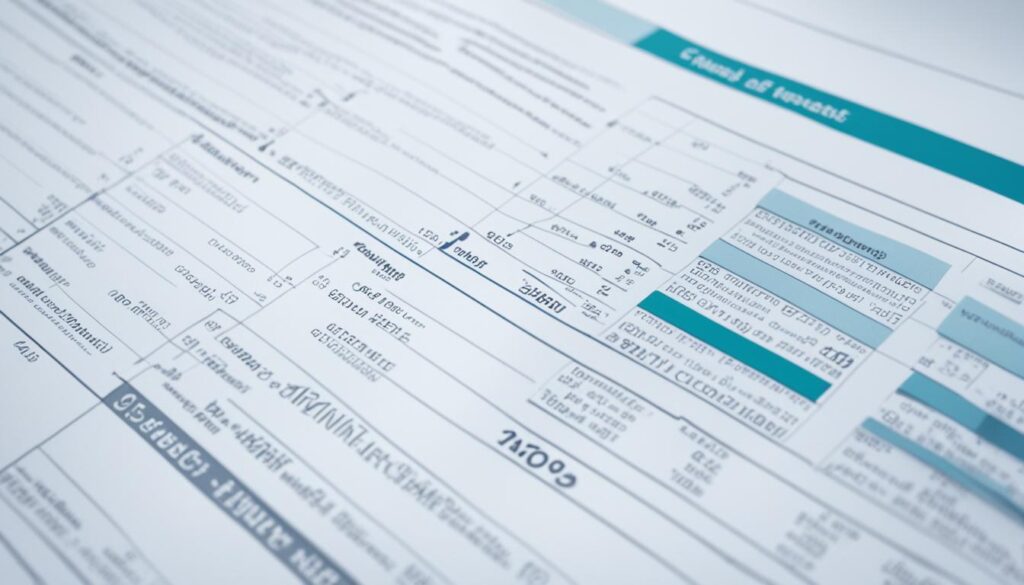Understanding Your Financial Documents Essentials

Keeping your financial files safe is key to good financial planning. Losing them could lead to big troubles.
Documents about your money are super important. They show what you own and owe, and how your money moves. Knowing and keeping them safe helps with good budgeting and protecting your private info.
We’ll talk about the key financial papers here. Knowing what to have and how to protect them matters a lot, for us and for businesses. It’s all about managing money wisely.
The Basics of Financial Statements
Financial statements show the money a company earned, spent, and has today. You don’t need deep finance knowledge to get them. Everyone can understand these statements with a little learning.
There are four main types of financial statements. They tell us about a company’s financial health and how it’s doing:
- Balance Sheets: Balance sheets show what a company owns, owes, and the shareholders’ part. They give us a clear picture of assets and debts at a set time.
- Income Statements: Income statements list a company’s sales, costs, and profits over time. They help see how well a company is making money and doing financially.
- Cash Flow Statements: These show how cash moves in and out of a business. They give clues on whether a company can handle its money well, showing how cash comes and goes.
- Statements of Shareholders’ Equity: These talk about any changes in a company’s value that’s owned by shareholders. They reflect how much the business has grown through owners’ investments and earnings.
Each statement talks about different parts of a company’s money and value. They allow us to fully understand its financial situation. We can use this to check on its stability and success.
Financial statements help make smart choices. They let us look at investing opportunities, review a company’s performance, and watch our money grow.
With the basics in mind, we’ll look deeper into each report. We’ll start by exploring the balance sheet in the next section.
The Balance Sheet: Understanding Assets, Liabilities, and Shareholders’ Equity
The balance sheet tells us about a company’s assets, debts, and what the owners own. It shows the company’s money picture at one point in time. This helps investors and experts see how well the company is doing.
Assets are things the company owns, like buildings or cash. They also include debts others owe, known as assets. The most easily changed to cash, like actual cash, come first on the list.
Liabilities are what a company owes to others. This covers everything from bank loans to bills not yet paid. Things due sooner are listed before those due later.
Shareholders’ equity is what remains after taking away debts from what the company owns. This shows how much the owners really own. It also includes the profits made over time or new money put in by the owners.
It’s important that Assets = Liabilities + Shareholders’ Equity. This balance sheet formula makes sure the numbers add up. Every dollar the company has comes from loans or what the owners have put in.

“The balance sheet is vital for understanding a company’s financial health,” says top analyst Jane Smith. “It shows what the company owns, owes, and what’s left for the owners. This helps investors know about its safety and worth.”
Studying the balance sheet helps investors and experts understand a company better. They can see if a company has too much debt, what it owns, and if it’s making money for its owners. It’s best when looked at along with other financial reports.
- Assets include:
- Physical property
- Investments
- Cash
- Intellectual property
- Liabilities can include:
- Loans
- Accounts payable
- Accrued expenses
- Other financial obligations
- Shareholders’ equity is determined by:
- Accumulated profits or losses
- Additional investments made by shareholders
- Changes in ownership
The balance sheet is key for making good financial decisions. For investors, lenders, and company owners, understanding it can provide great info. It offers a window into how the company is doing and its chances for success.
The Income Statement: Analyzing Revenues, Expenses, and Net Income
The income statement is key to understanding a company’s financial health. It shows the revenue made in a set time and the costs to get that revenue. By taking away the costs from the revenue, we get the net income, or the profit.
It’s all about checking if a company is making enough money. The statement tells us where the money comes from, like sales or fees. It also shows what they spend money on, like running the business or buying goods.
This statement starts with revenue, then lists the expenses, and finishes with the net income. This order shows how well a company turns sales into profit. It’s useful for investors and experts to see if a company is worth investing in.
Finding earnings per share is also important. It tells how much money each stockholder would get if all profit is shared. This is good for investors to understand how valuable their shares are.
Revenue Sales: $X Interest income: $X Total revenue: $X Expenses Cost of goods sold: $X Operating expenses: $X Depreciation expenses: $X Total expenses: $X Net Income Net income: $X
Looking at the income statement helps investors and analysts. It gives a deep look into the company’s money-making and spending. This helps in making smart choices about investing and understanding the company’s financial health.
The Cash Flow Statement: Tracking Inflows and Outflows of Cash
The cash flow statement is key to understanding a company’s cash movements. It details where money comes from and goes to. This helps see how it’s used for debts, costs, and growth.
It has three parts:
- Operating Activities: Shows cash from the main business, like sales. It tells if daily operations bring in or use cash.
- Investing Activities: Captures money from buying or selling big assets. This gives clues about the company’s future plans and growth.
- Financing Activities: Includes cash from loans, stocks, and dividends. It indicates how well a company can get funds and stay strong.
Investors and analysts find the cash flow statement very useful. It helps them understand the company’s money. This understanding is crucial for making smart investment choices and for tracking the business’s overall performance.
Looking at the cash flow statement alone isn’t enough. Usually, it’s best to study it with the balance sheet and income statement. This way, you get a full view of the company’s financial health.
Financial Statement Analysis: Interpreting and Evaluating Data
Understanding financial statements is key for investors and analysts. It helps them know a company’s financial health. This way, they can make smart choices about where to put their money. They look at numbers closely to see if a company is making money, has enough cash, and can grow in the future.
Looking at how well a company is doing financially is important. This means checking certain numbers, like how much money a company makes from its sales (profit) and its ability to pay its bills. Looking at these numbers helps experts see if a company is using its money and resources well.
Analysts also look at if a company can pay off its debts. They use special numbers to find this out. This helps them understand if a company is stable. Seeing how a company manages its money can also give clues about its future.
But financial analysis isn’t only about numbers. Experts also consider outside things that could affect a company, like what’s happening in the industry or how good a company’s leadership is. Including this kind of information helps investors and analysts have a full picture of a company’s situation.
“Financial statement analysis allows stakeholders to uncover meaningful insights into a company’s financial performance and make more informed investment decisions.”
Analyzing financial statements also means looking at how a company is doing compared to others in the same business. Experts check things like how quickly a company is growing its sales or how much profit it makes from its sales. This helps them see who the top companies are and who might need to work harder to get there.
It’s important to know that financial statements show past information. They might not always predict how well a company will do in the future. Also, not all companies report their financial information the same way. This can make it hard to compare one company to another. So, it’s smart to use other sources of information too.
Accounting Conventions and Reporting Standards
Financial statements are key to understanding a company’s financial health. They stick to rules for preparing them. In the U.S., companies use Generally Accepted Accounting Principles (GAAP). International firms follow International Financial Reporting Standards (IFRS).
GAAP and IFRS tell companies how to report on their money matters. This makes sure their reports are clear and can be easily compared. It helps those reading the reports understand them better.
It’s important to know about GAAP or IFRS for reading financial statements correctly. Analysts, investors, and others can make smart decisions if they understand these rules. They can compare different companies and industries accurately.
By following these rules, companies are more open about their finances. This helps everyone, from investors to the general public, know what’s really going on. It helps people make good choices about investing.

Key Features of GAAP and IFRS
- GAAP is a set of rules by the Financial Accounting Standards Board (FASB).
- IFRS is a global framework to make financial reports the same around the world, by the International Accounting Standards Board (IASB).
- GAAP has lots of detailed rules, while IFRS is based on broad principles.
- The U.S. mostly uses GAAP, while over 120 other countries use IFRS.
Following these rules leads to accurate, dependable financial reports, which is good for everyone who reads them.
Using standards like GAAP and IFRS makes financial reports clear and trustworthy. Companies that follow these rules make it easier for everyone to understand their finances. This means better decisions for those looking at the reports. Knowing about these rules is key for comparing financial information from different companies.
Importance of Notes to Financial Statements and Annual Reports
When you look at a company’s money situation, notes and reports are key. They tell us more details. These extra bits help us really get the picture of a company’s money matters.
Notes to Financial Statements: Unveiling Important Details
Notes in the financial statements reveal a lot. They talk about how money was accounted for, big changes, and risks. These notes make the company’s financial standing clearer.
“The notes to financial statements act as a bridge between the numbers on the financial statements and the real-world events and transactions that they represent.” – Jane Smith, Accounting Expert
For instance, notes might share when how the company counts money changes. They could talk about what a big building is worth. Or, they might mention what could go wrong. Looking at these notes helps people who invest or study companies know more. They can see if the money reports are done well.
Annual Reports: Providing a Comprehensive Overview
Annual reports are packed with info. They have financial statements, checks by auditors, and what the bosses think. These reports give us the full picture of a company’s year, including its goals and how it did financially.
The numbers part shows the company’s money status and how well it did. The auditors then check this for us to trust it. Plus, the bosses’ talk gives us the inside scoop. They discuss goals, worries, and what’s to come.
By looking at these reports, we understand more about the company’s health. Its strength in the market and if it’s keeping its promises clear up. It helps us decide if it’s a good idea to invest or do business with the company.
In conclusion, notes and reports are critical for understanding a company’s money life. They give us crucial details about how money is handled, big changes, and risks. Reviewing these helps us make smarter choices and get a real look at how the company is doing.
Conclusion
Being good at handling financial documents is key to safe and smart money planning. When you keep your important financial papers in order and safe, you make sure your records are correct. Also, you protect your private money details. Things like balance sheets and income statements help show how well a company is doing.
Learning how to read these statements and putting financial analysis to work helps investors and experts choose where to put their money. They can look at important financial numbers like profits and growth potential. This way, they figure out if a company is doing well financially. Having trustworthy financial records and analyzing them well are crucial for managing money well.
No matter if it’s you or a big company, staying on top of your financial paperwork is a must. By keeping everything organized and safe, you follow the rules, make smart money moves, and aim for financial success over time.






